Polk Audio Atrium 8, Atrium 7, Atrium 5 User Manual
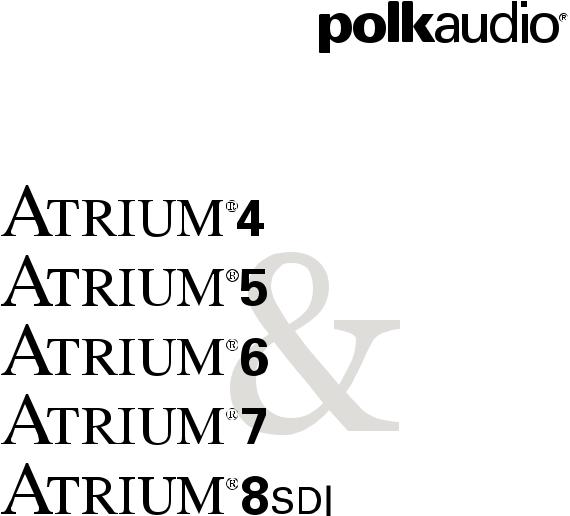
ENGLISH
FRANÇAIS
ESPAÑOL PORTUGUESE

English
IMPORTANT SAFETY INSTRUCTIONS
This product was designed and manufactured to meet strict quality and safety standards. There are, however, some installation and operation precautions which you
should be particularly aware of.
1.Read Instructions. All the safety and operating instructions should be read before the system is operated.
2.Retain Instructions. The safety and operating instructions should be retained for future reference.
3.Heed Warnings. All warnings on the appliances and in the operating instructions should be adhered to.
4.Follow Instructions. All operating and use instructions should be followed.
5.Attachments. Do not use attachments not recommended by the product manufacturer as they may cause hazards.
6.Accessories. Do not place these appliances on an unstable cart, stand, tripod, bracket, or table. The audio/video products may fall, causing serious injury to a child or adult, and serious damage to the products. Use only with a cart, stand, tripod, bracket, or table recommended by the manufacturer, or sold with the appliances. Any mounting of the appliances should follow the manufacturer’s instructions, and should use
mounting accessories recommended by the manufacturer.
7.Object and Liquid Entry. Never push objects of any kind into this product through openings, as they may touch dangerous voltage points or short out parts that could result in a fire or electric shock. Never spill liquid of any kind on this audio/video product.
8.Servicing. Do not attempt to service this product yourself, as opening or removing covers may expose you to dangerous voltage or other hazards. Refer
all servicing to qualified service personnel.
9.Damage Requiring Service. Unplug this product from wall outlets and refer servicing to qualified service personnel under the following conditions:
a.If liquid has been spilled, or objects have fallen into the product.
b.If the product does not operate normally by following the operating instructions. Adjust only those controls that are covered by the operating instructions, as
an improper adjustment of other controls may result in damage and will often require extensive work by a qualified technician to restore the product to its normal operation.
c.If the product has been dropped or the cabinet has been damaged.
d.When the product exhibits a distinct change in performance—this indicates a need for service.
10.Replacement Parts. When replacement parts are required, be sure the service technician has used replacement parts specified by the manufacturer or that the parts have the same characteristics as the original part. Unauthorized substitutions may result in fire, electric shock or other hazards.
11.Safety Check. Upon completion of any service or repairs to this product, ask the service technician to perform safety checks to determine that the products are in proper operating condition.
SAFE LIMITS OF OPERATION
Polk Audio specifies the recommended amplification range for each of its passive (non-amplified) loudspeakers. Typically that specification will be expressed as a range of power such as 20-200 Watts (per channel). It is important to understand what those numbers mean when choosing a receiver or amplifier for your Polk Audio loudspeakers. The lower number indicates the lowest continuous rated power that will yield acceptable performance in a typical listening environment. The higher number indicates the highest per channel power that should be used with your Polk Audio speakers. That number should not be confused with a “Power Handling” specification and it does not imply that the speaker will safely handle that full amount of power on a long-term basis. We specify a wide range of power ratings because not all electronics manufacturers use the same method
for rating power. In fact, high quality lower-rated amplifiers sound better and play louder than low quality units with higher power rating.
Automobile horsepower is a good analogy. Your car probably has far more horsepower than it needs for your daily commute and is likely capable of going well over 120mph (190km/hr). Having that extra power is good
for on-ramp acceleration and danger avoidance (like getting away from brain-eating zombies) but that doesn’t mean that it is advisable to operate your car on North American highways at full power and maximum speed for an extended period of time. Just ask your local state trooper if you are in doubt. Similarly, we recommend using amplifiers and receivers with rated power above the power handling limits of our speakers because having extra power available for short term peaks
is conducive to better sound quality, maximum dynamic range and effortless high volume output. But we strongly urge you not to use the full power of your amplifier
or receiver for daily listening.
Loudspeakers can be damaged when an amplifier, regardless of its wattage, is made to play at higher listening levels than its power can clearly produce. Operation at this level can result in very high levels of audible distortion originating
in the amplifier, which can add a harsh, gritty sound to your listening material. If you hear distortion—turn the volume down or risk damaging your speakers. You can damage just about any speaker, regardless of power rating, if you drive an amplifier to or beyond the point of distortion.
PRODUCT DISPOSAL
Certain international, national and/or local laws and/or regulations may apply regarding the disposal of this product. For further detailed information, please contact the retailer where you purchased this product
or the Polk Audio Importer/ Distributor in your country. A listing of Polk Audio Importer/ Distributors can be found on the Polk Audio website www.polkaudio.com or by contacting Polk Audio at: 5601 Metro Drive, Baltimore,
Maryland 21215, USA Phone: +1 410 358-3600.
TECHNICAL ASSISTANCE OR SERVICE
If, after following the hookup directions, you experience difficulty, please double-check all wire connections. Should you isolate the problem to the speaker, contact the authorized Polk Audio dealer where you made your purchase, or contact Polk Audio Customer Service 800-377-7655 (M-F, 9am-6pm EST, US & Canada only) or via email polkcs@polkaudio.com. Outside the US
& Canada, call 410-358-3600. More detailed information including audio how-to articles, FAQs and online manuals are available on our award-winning website: www.polkaudio.com.
2 |
Polk Audio Customer Service 800-377-7655 (Outside USA & Canada: 410-358-3600) |
Customer Service Hours of Operation: Monday-Friday, 9AM-6PM EST |
polkcs@polkaudio.com |
3 |

PLACEMENT OPTIONS
Atrium Series loudspeakers were created
to live and play outdoors. Atriums have a wide dispersion pattern, and are also very efficient. This means your Atrium Series loudspeakers will deliver exceptional sound quality throughout a large listening area. However, if you want high sound levels in an outdoor setting with acoustic characteristics that differ from those of indoor conditions, we recommend multiple-pair setups.
In addition to the placement locations typically used for outdoor loudspeakers, all Atrium Series loudspeakers have built-in stability feet, which allows the loudspeakers to be placed securely on a shelf or other flat horizontal surface.
Please keep in mind that you’ll maximize the useful life of your Atrium loudspeakers by locating them where they’ll receive less exposure to the elements, under eaves for example. When locating your Atrium loudspeakers outdoors, take into account three factors: sound quality, convenience and exposure to the elements.
FIGURE 1: Place the speaker in a corner for more bass output. Bracket attached to side wall.
FIGURE 3: Place the speaker close under an eave for more bass output.
FIGURE 2: Place the speaker away from eaves and corners for less bass output.
FIGURE 4: The Atrium’s built-in stability feet ensure safe, secure placement on a shelf
of other flat surface.
PREPARING TO PAINT
Before you paint, you will need:
•A spray can of primer paint (Krylon Sandable Spray Primer #1318).
•A spray can of the paint of your choice. Choose exterior grade paint if you plan to use the speakers outdoors.
•A paperclip or corkscrew (for removing the paintable grille).
•Masking tape.
•Paint mask to cover unpaintable parts (not included). To make an easy paint mask, use the grille as a template and cut a mask from heavy, nonporous Kraft paper.
1.Separate the parts of the speaker: Remove the brackets and bracket knobs. Remove the grille by carefully hooking it with a bent paper clip and pulling it gently away from the cabinet [figure 5].
2.Mask off the binding posts on the back of the speaker [figure 6], the end panels and bracket knobs, and carefully mask off the front of the speakers to protect the drivers and baffles while painting [figure 7]. The grille has a logo on it, which you may mask off should you choose not to paint over it.
FIGURE 5: Remove the grille using a paper clip.
FIGURE 6: Mask the binding posts on the rear of the speaker.
FIGURE 7: Mask the drivers and baffles.
4 |
Polk Audio Customer Service 800-377-7655 (Outside USA & Canada: 410-358-3600) |
Customer Service Hours of Operation: Monday-Friday, 9AM-6PM EST |
polkcs@polkaudio.com |
5 |
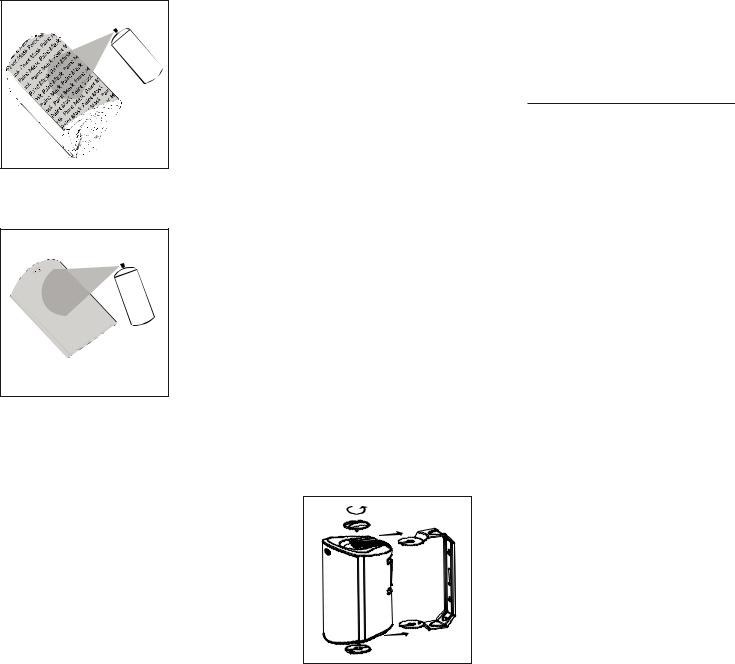
PAINTING THE CABINET, BRACKET KNOBS & BRACKET
1.Apply two thin coats of primer to the cabinet and knobs. The bracket does not require
a primer.
2.Only after the primer is completely dry should you apply the finish color [figure 8].
3.Do not remove the masking material (not included) until the paint is completely dry.
4.Do not reattach the speaker to the bracket until the bracket is mounted. Try to handle any freshly painted parts as little as possible.
PAINTING THE GRILLE
1.Atrium loudspeaker grilles have an even, protective powder coating. This powder coating is an ideal primer. The grille has a logo pod, which you may mask off
or paint right over.
2.Using spray paint, spray two thin coats of finish color [figure 9]. If you’re using
a compressor and spray gun, use the finest, most diffuse setting. Be careful not to fill the holes in the grille with paint.
3.When the paint is completely dry, carefully fit the grille into its recess so that it just rests on the cabinet. Starting with one corner, work around the speaker and push the grille into the grille notch a little at a time.
Be gentle; the grille may be easily bent by rough handling.
FIGURE 8: After priming, apply thin coats of finish color.
FIGURE 9: Paint the grille. Use thin coats of spray paint. Do not block grille holes with paint.
MOUNTING OPTIONS (SAFETY FIRST)
When installing Atrium loudspeakers note the weight of your particular model and the weight bearing tolerance of the material to which you’re mounting the speaker. If you’re not sure of a safe way of mounting your speakers, please consult a professional installer, your authorized Polk Audio dealer or a building contractor.
You’ll maximize the useful life of your Atrium loudspeakers by placing them where they’ll receive less exposure to the elements. If extreme weather conditions are expected, we recommend storing your speakers indoors.
Look for the best overall compromise between sound quality, convenience and exposure. Never compromise safety.
The Atrium’s Speed-Lock™ mounting bracket enables you to mount the speaker either horizontally or vertically. The Speed-Lock bracket holds the speaker in place so you can easily aim the speaker to deliver the best possible sound in
a variety of situations. Follow the steps below to safely secure the brackets and speakers.
Installing Atrium Series loudspeakers requires basic skills in using tools such as a drill and screwdriver. If you are in doubt that you possess the necessary skills or tools, consult your
Polk Audio dealer, or a professional installer.
Horizontal & Vertical Mounting
1.Verify the material on which you plan to mount the speakers (plaster, drywall, paneling, stone, etc.) can support the weight of the speakers:
Speaker Weights
Atrium4 |
3.6lbs / 1.63kg each |
Atrium5 |
4.6lbs / 2.09kg each |
Atrium6 |
5.4lbs / 2.45kg each |
Atrium7 |
8lbs / 3.63kg each |
Atrium8SDI |
9.7lbs / 4.4kg each |
2.Ensure the locations you select do not conceal electrical wiring or plumbing.
3.Before you install the speaker, hold it in the chosen location to make sure it safely clears obstacles such as ceiling, adjacent walls, corners, beams, lighting fixtures and door/window frames.
4.Using the keyhole slots in the bracket as a template, mark the installation location of the two keyhole slots with a pencil. You can do this by removing the bracket knobs on the top and bottom of the speaker and removing the bracket [figure 10].
5.Position the bracket so that the small ends
of the keyhole slots are facing “up” according to the direction of installation.
FIGURE 10: Turn the bracket knobs to remove the bracket assembly.
6 |
Polk Audio Customer Service 800-377-7655 (Outside USA & Canada: 410-358-3600) |
Customer Service Hours of Operation: Monday-Friday, 9AM-6PM EST |
polkcs@polkaudio.com |
7 |
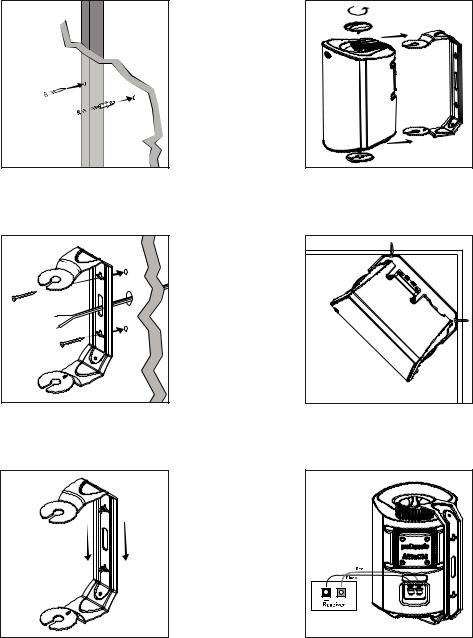
6.If you are certain there is a stud behind the wall surface, drive #10 screws (not included) through the wall and into the stud [figure 11a].
7.If there is no stud behind the wall at the chosen location, install #10 wall anchors (not supplied) into the wall by following the wall-anchor-manufacturer’s instructions. Always use two wall anchors and two screws per speaker [figure 11b].
8.Drive the screws into the stud or wall anchors, leaving screw heads protruding 1/8"~1/4" (3mm~6mm).
9.If you’re feeding speaker wire through a hole in the wall behind the bracket, pull this speaker wire through the hole in the bracket before mounting the bracket [figure 12].
10.Screw the bracket directly into a weightbearing stud on the mounting surface. Place the screws securely in the smaller end of the keyhole slot. Do not leave screw heads protruding.
Note: All Atrium loudspeaker cabinets have molded ramps, which guide the speaker bracket onto threaded protrusions to which the bracket knobs attach.
11.Screw the bracket knobs into the protrusions but do not tighten them securely.
12.Secure the speaker to the bracket by sliding the speaker between the bracket arms. The built-in ramps will spread the bracket slightly and guide the ends of the bracket onto the threaded protrusions. A ratcheting system holds the speaker in place and helps you fine tune how you want to aim it. [figure 14].
13.Secure the loudspeaker to the bracket
by tightening the adjusting bracket knobs.
11a Wall Stud |
11b No Wall Stud |
FIGURE 11a & 11b: Use #10 screw for wall stud, use #10 wall anchors and screw for no wall stud.
FIGURE 12: Feed speaker wire from wall through bracket wire hole for easy mounting.
FIGURE 13: Slide the bracket down on
the screw heads to catch the keyhole slots.
FIGURE 14: Turn the bracket knobs to remove the bracket assembly.
FIGURE 15: Installation of the 45° bracket.
FIGURE 16: Make speaker connection using binding posts.
14.Tug gently on the speaker to make certain that the screws and bracket are properly aligned and that the wall anchors are secure.
15.If the bracket is not held snug against the wall by the screw heads, remove the speaker from the wall, drive the screws in a little further and then remount the speaker.
16.Once the speaker is mounted, the bracket knobs can be loosened to “aim” the speaker, and then hand tightened to keep the speaker angled correctly.
VERTICAL MOUNT AIMED 45° DOWN
The Atrium Series mounting bracket is designed so the speakers may be mounted in a vertical 45° downward firing position [Figure 15].
Use an anchoring device that can support the weight of your Atrium model and be sure the material you are mounting the loudspeaker to can support its weight.
RECEIVER HOOKUP
Follow the hookup directions included with your receiver. Strip 1/2" of insulation from each of the two conductors of the wire to expose
the bare metal and twist each of the conductors into a single un-frayed strand (so you have
two unfrayed strands).
Note that one of the terminals on the rear of each speaker is red (+) and the other is black (–). Make certain that you connect the wire from the red terminal of your amplifier or receiver
to the red terminal on your speaker; and the wire from the black terminal of your amplifier or receiver to the black terminal on your speaker [figure 16]. Most wire has some indicator (such as color-coding, ribbing or writing) on one of the
two conductors to help you maintain consistency.
8 |
Polk Audio Customer Service 800-377-7655 (Outside USA & Canada: 410-358-3600) |
Customer Service Hours of Operation: Monday-Friday, 9AM-6PM EST |
polkcs@polkaudio.com |
9 |
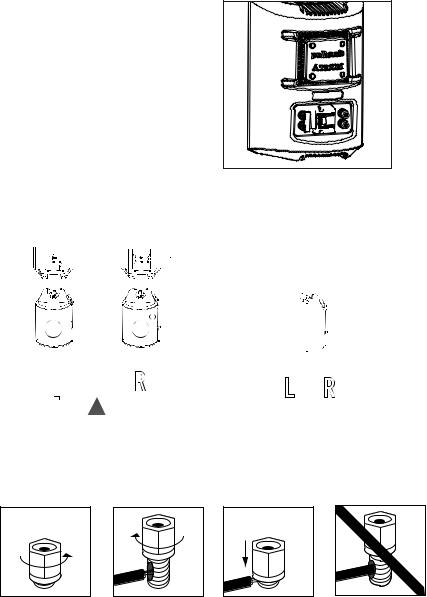
ATRIUM8SDI DUAL INPUT/SINGLE
INPUT SWITCH
The Atrium8SDI has a patented dual input/single input switch. this switch enables the Atrium8SDI to be used either as a single high-performance stereo loudspeaker, or the left-or-right speaker in a high performance stereo pair [Figure 17].
|
|
FIGURE 17: Rear view of the Atrium8SDI. |
|
TO RECEIVER |
TO RECEIVER |
TO RECEIVER |
TO RECEIVER |
LEFT CHANNEL |
RIGHT CHANNEL |
LEFT CHANNEL |
RIGHT CHANNEL |
|
|
|
|
|
|
|
|
STEREO PAIR |
SINGLE HOOKUP |
USING 5-WAY BINDING POSTS
Loosen hex nut. |
Insert speaker wire |
Tighten hex nut. |
Do not insert insulated |
|
through hole. |
|
section of speaker wire. |
10 Polk Audio Customer Service 800-377-7655 (Outside USA & Canada: 410-358-3600)
Customer Service Hours of Operation: Monday-Friday, 9AM-6PM EST |
polkcs@polkaudio.com |
11 |

Français
IMPORTANTES CONSIGNES DE SÉCURITÉ
Ce produit a été conçu et fabriqué pour répondre à de strictes normes de qualité et de sécurité. Veuillez cependant porter attention aux consignes de sécurité suivantes se rapportant
àson installation et à son utilisation.
1.Lisez toutes les consignes de sécurité et d’utilisation avant d’utiliser cet appareil.
2.Conservez les consignes de sécurité et d’opération pour référence future.
3.Observez les consignes contenues dans ce manuel et affichées sur l’appareil.
4.Suivez toutes les instructions d’opération et d’utilisation.
5.Accessoires: n’utilisez jamais d’accessoires qui ne sont pas recommandés par le fabricant. Ils pourraient provoquer un danger.
6.Ne placez jamais cet appareil sur un charriot, socle, meuble ou support instable. L’appareil pourrait tomber, s’endommager et/ou blesser grièvement un enfant ou un adulte. N’utilisez qu’un charriot, socle, meuble ou
support spécifié par le fabricant ou vendu avec l’appareil. Toute installation de l’appareil doit se faire selon les directives du fabricant et en utilisant des accessoires recommandés par le fabricant.
7.Objets et liquides: n’insérez jamais d’objets dans les ouvertures de cet appareil. Ils pourraient entrer en contact avec des points de voltage dangereux
et provoquer des courts-circuits et entrainer un risque d’incendie ou de choc électrique. Prenez garde de
ne jamais renverser de liquides sur l’appareil.
8.Entretien et réparation: ne tentez jamais de réparer cet appareil vous-même car ouvrir son boîtier ou en
retirer le couvercle pourrait vous exposer à des voltages dangereux ou à d’autres dangers. Confiez tout entretien ou réparation à un technicien qualifié.
9.Dommages requérant la réparation: Débranchez l’appareil de la prise CA et contactez un réparateur qualifié lorsque:
a.un objet ou du liquide s’est introduit dans l’appareil;
b.l’appareil ne fonctionne pas normalement selon les instructions du fabricant. Réglez uniquement les contrôles spécifiés dans le manuel d’utilisation
car le réglage inapproprié de certains autres contrôles pourrait endommager l’appareil et requérir l’intervention d’un réparateur qualifié pour le remettre en ordre.
c.l’appareil a subi une chute ou son boîtier a été endommagé;
d.l’appareil ne semble pas fonctionner normalement — ce qui indique la nécessité de réparation ou d’entretien.
10.Pièces de rechange: lorsque des pièces de rechange sont requises, assurez-vous que le technicien en réparation utilise des pièces de rechange spécifiées par le fabricant ou des pièces ayant les mêmes caractéristiques que
les pièces d’origine. Des substitutions non autorisées risquent de provoquer un incendie, un choc électrique ou d’autres dangers.
11.Contrôle de sécurité: après chaque entretien ou réparation de cet appareil, demandez au technicien d'effectuer
un contrôle pour confirmer que l’appareil est en bon état de fonctionnement.
LIMITES D’OPÉRATION
Polk Audio spécifie la gamme de puissance d’amplification recommandée pour chacun de ses haut-parleurs non amplifiés. Cette spécification est typiquement exprimée en watts par canal (par ex. 20-200 W/canal). Il est important de bien comprendre la signification de ces chiffres avant de choisir un amplificateur ou un récepteur pour vos haut-parleurs. Le premier chiffre indique la puissance nominale minimum requise pour assurer une performance convenable dans une pièce normale. Le deuxième chiffre indique la puissance nominale maximum admissible par vos haut-parleurs—ce chiffre ne doit pas être confondu avec la spécification de «capacité de puissance»
et n’implique pas que le haut-parleur peut soutenir cette puissance de façon continue sans risque d’endommagement. Nous spécifions une gamme de puissance d’amplification étendue parce que les fabricants de composants électroniques n’utilisent pas toujours la même méthode pour déterminer
la puissance admissible. En fait, les amplificateurs moins puissants de qualité supérieure donnent un meilleur rendement que les amplificateurs plus puissants
de qualité inférieure.
L’automobile et les chevaux-vapeur sont une bonne analogie. Votre automobile a beaucoup plus de chevaux-vapeur que ceux requis par son utilisation quotidienne, vous permettant probablement d’atteindre les 190 km/h ou plus! Vous ne roulez pas pour autant à fond la caisse en tout temps (du moins nous l’espérons). Cependant, cette réserve de puissance vous permet de bien accélérer sur les rampes d’accès, d’éviter les accidents et de doubler sécuritairement. C’est pour cette même raison que nous vous recommandons d’utiliser un amplificateur ou un récepteur d’une puissance nominale
plus élevée que la capacité de puissance spécifiée pour vos haut-parleurs. En effet, cette réserve de puissance leur permettra de reproduire les crêtes sonores momentanées sans effort et sans distorsion, assurant une gamme dynamique maximale et une performance optimale, même
à très haut volume. Il est quand même fortement déconseillé d’écouter votre chaîne audio «à fond la caisse» en tout temps.
Un haut-parleur peut être endommagé lorsqu’un amplificateur, quelle que soit sa puissance, est poussé au delà de ses limites. L’amplificateur surchargé génère alors un niveau
élevé de distorsion audible, le son devenant rauque et éraillé.
Si vous entendez de la distorsion, baissez le volume sinon vous risquez d’endommager vos haut-parleurs.
Un haut-parleur, quelle que soit sa capacité de puissance, risque d’être endommagé lorsque l’amplificateur
est poussé au delà de ses limites de distorsion.
RÉCUPÉRATION DU PRODUIT
Certaines lois ou certains règlements internationaux, nationaux et/ou régionaux pourraient s’appliquer à la récupération de ce produit. Pour plus d’information, communiquez avec le revendeur de ce produit ou avec l’impor-tateur/distributeur de ce produit dans votre pays. Vous trouverez la liste des importateurs/ distributeurs des produits Polk Audio
sur le site www.polkaudio.com ou en communiquant avec Polk Audio:
5610 Metro Drive, Baltimore, Maryland 21215, USA—Tél.: +1 410 358-3600.
SERVICE OU ASSISTANCE TECHNIQUE
Si, après avoir suivi toutes les instructions, vous éprouvez des difficultés, vérifiez toutes vos connexions. Si vous en concluez que le problème est relié au haut-parleur, communiquez avec votre revendeur Polk Audio ou contactez le Service à la Clientèle de Polk Audio au 1-800-377-7655
(L-V, 9-18, HNE, Canada et É.-U. seulement). À l’extérieur des É.-U. et du Canada, composez le 410-358-3600. Vous pouvez aussi nous contacter par courriel à l’adresse: polkcs@polkaudio.com. Pour plus d’information— incluant des chroniques pratiques, des FAQ et des manuels d’utilisation en ligne, visitez notre site
web primé: www.polkaudio.com.
12 |
Polk Audio Customer Service 800-377-7655 (Outside USA & Canada: 410-358-3600) |
Customer Service Hours of Operation: Monday-Friday, 9AM-6PM EST |
polkcs@polkaudio.com |
13 |
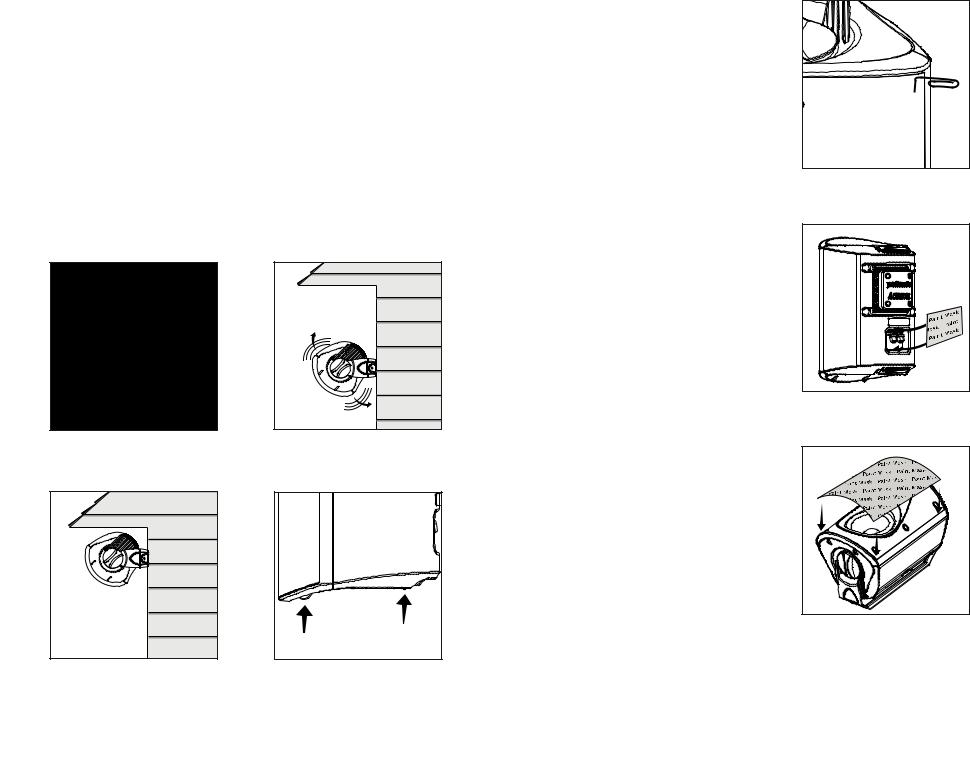
OPTIONS D’INSTALLATION
Les enceintes Atrium ont été conçues pour usage extérieur ou intérieur. Elles sont très efficaces et grâce à leur vaste dispersion acoustique elles vous assurent une excellente reproduction sonore même dans de grands espaces; mais si vous désirez un volume très élevé à l’extérieur, il est recommandé d’en installer plusieurs paires car les propriétés acoustiques extérieures diffèrent des propriétés acoustiques intérieures.
Les enceintes de la Série Atrium peuvent être installées de façon conventionnelle, mais elles sont toutes dotées de pieds intégrés, leur assurant une grande stabilité sur une étagère ou autre surface plate.
Vous prolongerez la vie utile de vos enceintes Atrium en les installant autant que possible à l’abri des intempéries. Tentez de trouver un
compromis entre la fonction, la qualité sonore et l’exposition aux intempéries.
FIGURE 1: Installez l’enceinte à proximité d’un coin pour augmenter les graves. Support fixé à un mur latéral.
FIGURE 3: Installez l’enceinte à proximité de l’avant-toit pour augmenter les graves.
FIGURE 2: Installez l’enceinte à distance de l'avant-toit et des coins pour réduire les graves.
FIGURE 4: Les pieds intégrés assurent la stabilité de l’enceinte sur une étagère ou surface plate.
PEINTURE DE VOS
ENCEINTES ATRIUM
Pour peindre vos enceintes, vous aurez besoin de:
•Peinture d’apprêt en aérosol (peinture de fond en aérosol Krylon #1318).
•Peinture de finition de votre choix (en aérosol). Utilisez une peinture d’extérieur si vous comptez installer vos enceintes à l’extérieur.
•Un trombone ou un tire-bouchon.
•Du ruban-cache.
•Un cache-peinture (non-compris) pour couvrir les pièces non-peinturables de l’écran acoustique. Pour fabriquer
facilement ce cache-peinture, découpez du papier kraft en utilisant la grille comme gabarit.
1.Retirez d’abord les boutons des supports et les supports. Retirez ensuite la grille en l’accrochant délicatement avec un trombone replié et le retirant doucement de l’enceinte [figure 5].
2.Masquez le panneau et les bornes situés à l’arrière de l’enceinte [figure 6], puis masquez la surface avant des enceintes pour protéger les transducteurs et l’écran acoustique lors de l’application de la peinture [figure 7]. Masquez le logo Polk situé sur la grille. Masquez également
la portion vissable des boutons et les douilles filetées situées aux extrémités des enceintes.
FIGURE 5: Retirez la grille en utilisant un trombone.
FIGURE 6: Masquez les bornes situées à l’arrière de l’enceinte.
FIGURE 7: Masquez l’écran acoustique et les transducteurs.
14 |
Polk Audio Customer Service 800-377-7655 (Outside USA & Canada: 410-358-3600) |
Customer Service Hours of Operation: Monday-Friday, 9AM-6PM EST |
polkcs@polkaudio.com |
15 |
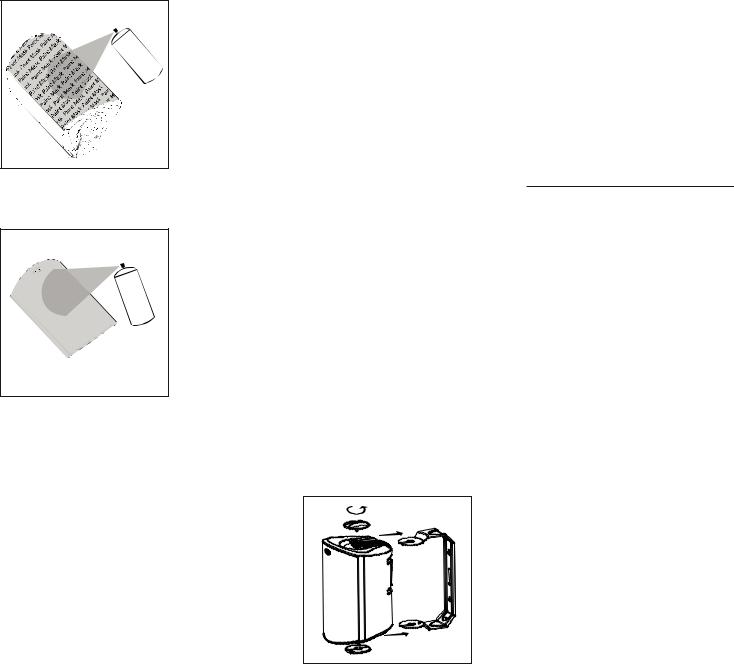
PEINTURE DES CAISSONS, DES SUPPORTS ET DES BOUTONS
1.Appliquez deux minces couches de peinture d’apprêt aux caissons et aux boutons.
Les supports ne requièrent pas d’apprêt.
2.Lorsque la peinture d’apprêt est complètement sèche, appliquez la peinture de finition [figure 8].
3.Ne retirez pas les cache-peinture avant que la peinture de finition ne soit complètement sèche.
4.Ne réinstallez pas l’enceinte dans son support avant que la peinture ne soit complètement sèche. Évitez autant que possible de manipuler les pièces fraîchement peintes.
PEINTURE DE LA GRILLE
1.La grille des enceintes Atrium est enduite d’un revêtement de poudre protectrice. Ce revêtement constitue un apprêt idéal. Masquez le logo Polk si vous désirez
le garder apparent.
2.Appliquez deux minces couches de peinture de finition en aérosol [figure 9]. Si vous utilisez un pistolet pulvérisateur, choisissez le réglage le plus fin, le plus diffus. Assurezvous de ne pas obstruer les trous de la grille avec la peinture.
3.Lorsque la peinture est complètement sèche, posez délicatement la grille sur l’écran acoustique de l’enceinte. En commençant par un coin, poussez petit à petit la grille dans son encoche tout autour de l’écran.
Soyez délicat, la grille peut être facilement déformée.
FIGURE 8: Après la couche d’apprêt, appliquer de minces couches de finition.
FIGURE 9: Peinture de la grille. Appliquer de minces couches de peinture en aérosol. N’obstruez pas les trous avec la peinture.
INSTALLATION (SÉCURITÉ AVANT TOUT)
Lorsque vous installez des enceintes Atrium, soyez conscient du poids du modèle que vous installez et des tolérances de charge portante du matériau sur lequel vous les installez. Si vous avez des doutes sur la méthode d’installation sécuritaire de vos enceintes, consultez votre revendeur Polk, un installateur professionnel ou un spécialiste en bâtiment. Ne faites jamais de compromis en matière de sécurité.
Vous prolongerez la vie utile de vos Atrium en les installant autant que possible à l’abri des intempéries. En cas de conditions atmo sphériques extrêmes, il est recommandé de les remiser à l’intérieur. Tentez de trouver un compromis entre la fonction, la qualité sonore et l’exposition aux intempéries.
Ne faites jamais de compromis en matière de sécurité.
Le support Speed-Lock™ de l’enceinte Atrium permet une installation verticale ou horizontale; il permet également d’orienter l’enceinte pour obtenir la propagation sonore optimale. Suivez les étapes suivantes pour installer le support et l’enceinte de façon sécuritaire.
L’installation des enceintes de la Série Atrium requiert une compétence technique rudimentaire et des outils ordinaires (tournevis et perceuse).
Si vous ne croyez pas être assez habile ou ne possédez pas les outils nécessaires, consultez votre revendeur Polk ou un installateur professionnel.
Installation en position horizontale ou verticale
1.Assurez-vous que le matériau sur lequel vous comptez installer vos enceintes (plâtre, placoplâtre, lambris, pierre, etc.) peut supporter le poids des enceintes.
L’enceinte pèse:
Atrium4 |
3.6lbs / 1.63kg ch. |
Atrium5 |
4.6lbs / 2.09kg ch. |
Atrium6 |
5.4lbs / 2.45kg ch. |
Atrium7 |
8lbs / 3.63kg ch. |
Atrium8SDI |
9.7lbs / 4.4kg ch. |
2.Assurez-vous que l’endroit choisi ne dissimule pas de fils électriques ou de plomberie.
3.Avant d’installer l’enceinte, tenez-la à l’endroit choisi pour vous assurer qu’elle sera suffisamment dégagée du plafond, des murs adjacents, des coins, des poutres, des luminaires et des cadres de portes
et de fenêtres.
4.Utilisant le support comme gabarit, marquez la position des deux fentes en trou de serrure à l’aide d’un crayon. Vous pouvez le faire en retirant les boutons du support de l’enceinte et en la dégageant du support [figure 10].
5.Placez le support (position verticale ou horizontale au choix) de façon à ce que la partie rétrécie des fentes en trou
de serrure soit située en haut.
FIGURE 10: Dévissez les boutons pour retirer le support.
16 |
Polk Audio Customer Service 800-377-7655 (Outside USA & Canada: 410-358-3600) |
Customer Service Hours of Operation: Monday-Friday, 9AM-6PM EST |
polkcs@polkaudio.com |
17 |
